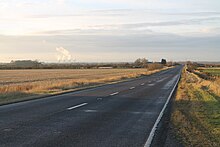A1500 road
| A1500 | |
|---|---|
| Route information | |
| Length | 8.6 mi (13.8 km) |
| Major junctions | |
| From | Marton 53°19′42″N 0°44′25″W / 53.3284°N 0.7404°W |
A15 | |
| To | Scampton 53°17′28″N 0°32′32″W / 53.291°N 0.5422°W |
| Location | |
| Country | United Kingdom |
| Constituent country | England |
| Primary destinations | Sturton by Stow |
| Road network | |




The A1500 is an A road entirely within the English county of Lincolnshire. It links the A156 at Marton with the A15 south of RAF Scampton via Sturton by Stow.[1]
The A1500 follows the Roman road Till Bridge Lane and at the very end at Scampton, Horncastle Lane. This Roman Road was part of the Alternative route from Lincoln to York used when the Humber was impassable, and is thus associated with Ermine Street in the Antonine Itinerary.
Route
The A1500 starts in the village of Marton, at SK840820, and runs south of east along the Roman alignment. The junction in the Village is actually a crossroads: The Roman alignment is maintained toward the west, crosses the River Trent to Littleborough, Nottinghamshire, and can be intermittently discovered nearly to Bawtry. (None of this is part of the A1500.)
The A1500 follows the Roman Road through Sturton by Stow at SK890803, crosses the River Till by Till Bridge Farm at SK908797, until SK947784 near Scampton village. From here the modern road deviates almost due east, and ends at SK973781, the junction with the modern A15, Roman Ermine Street, south of RAF Scampton.
The whole length along the Roman Road is known as Till Bridge Lane. The section from the deviation at SK947784 to the roundabout on the A15 is named Horncastle Lane. The name Horncastle Lane continues on the other side of the A15, but that is a minor road not part of the A1500 designation.
The A1500 is single carriageway throughout.
The Roman Road alignment from SK947784 near Scampton is maintained across fields, and also makes a junction with the A15 Ermine Street at SK973774. This is the main entrance to the Lincolnshire Showground, which is based around the Roman Road.
See also
References
- "Tilbridge Lane". Lincolnshire HER. Heritage gateway. Retrieved 6 August 2013.*
- Allen, Thomas (1834). The history of the county of Lincoln: from the earliest period to the present time. Lincoln: J. Saunders, Jr. p. 47. Retrieved 6 August 2013.
roman road tillbridge lane.
– references to the Roman Road, at Manton, Stourton,
External links
- Felix Oswald (January 1933). "The Roman Roads of Nottinghamshire". The Nottinghamshire Magazine. 1 (3). Retrieved 6 August 2013.
The other definitely Roman road across the county from Lincoln to Doncaster is less known, although the route can still be clearly traced and is distinctly marked on the Ordnance map. This road would seem to have been a branch of the Ermine Street, being preferred perhaps to the more direct road to York, which involved a crossing of the Humber. This road leaves the Ermine Street just north of Lincoln, crosses the Trent at Littleborough and continues via North Wheatley through Bawtry to Doncaster.
- Codrington, Thomas (1903). (7) Lincoln to Tadcaster. Roman Roads in Britain. London: Society for Promoting Christian Knowledge. Retrieved 6 August 2013.
- Historic England. "Segelocum (324920)". Research records (formerly PastScape). Retrieved 6 August 2013. – description of Roman town on the banks of the Trent, where the Roman Road crossed.
- "Sabre, A1500". Retrieved 19 May 2012.
- "The Marton Auxiliary Fort".

